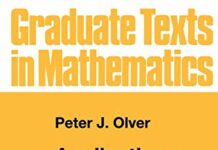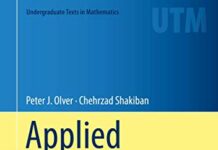
Ebook Info
- Published: 2098
- Number of pages: 661 pages
- Format: PDF
- File Size: 14.70 MB
- Authors: Peter J. Olver
Description
This textbook is designed for a one year course covering the fundamentals of partial differential equations, geared towards advanced undergraduates and beginning graduate students in mathematics, science, engineering, and elsewhere. The exposition carefully balances solution techniques, mathematical rigor, and significant applications, all illustrated by numerous examples. Extensive exercise sets appear at the end of almost every subsection, and include straightforward computational problems to develop and reinforce new techniques and results, details on theoretical developments and proofs, challenging projects both computational and conceptual, and supplementary material that motivates the student to delve further into the subject. No previous experience with the subject of partial differential equations or Fourier theory is assumed, the main prerequisites being undergraduate calculus, both one- and multi-variable, ordinary differential equations, and basic linear algebra. While the classical topics of separation of variables, Fourier analysis, boundary value problems, Green’s functions, and special functions continue to form the core of an introductory course, the inclusion of nonlinear equations, shock wave dynamics, symmetry and similarity, the Maximum Principle, financial models, dispersion and solutions, Huygens’ Principle, quantum mechanical systems, and more make this text well attuned to recent developments and trends in this active field of contemporary research. Numerical approximation schemes are an important component of any introductory course, and the text covers the two most basic approaches: finite differences and finite elements.
User’s Reviews
Editorial Reviews: Review “This textbook furnishes the basis for a 1-year introductory course in partial differential equations for advanced undergraduates. … The book is written with great care and great attention to detail throughout. At the end of every chapter there are well-chosen exercises that genuinely add depth to the concepts treated in the text. … this book can be wholeheartedly recommended.” (M. Kunzinger, Monatshefte für Mathematik, Vol. 181, 2016)“This book easily covers all the material one might want in a course aimed at first-time students of PDEs. … I recommend this one highly: It provides the best first-course introduction to a vast and ever-more relevant and active area. Students, and perhaps instructors too, will learn much from it. If they wish to go beyond the material taught in a first course, this text will prepare them better than any other I know.” (SIAM Review, Vol. 56 (3), September, 2014)“Introduction to Partial Differential Equations is a complete, well-written textbook for upper-level undergraduates and graduate students. Olver … thoroughly covers the topic in a readable format and includes plenty of examples and exercises, ranging from the typical to independent projects and computer projects. … Instructors teaching an introduction to partial differential equations course will want to consider this textbook as a viable option for their students. Summing Up: Highly Recommended. Upper-division undergraduates, graduate students, and faculty.” (S. L. Sullivan, Choice, Vol. 51 (11), July, 2014)“This introduction to partial differential equations is addressed to advanced undergraduates or graduate students … . an imposing book that includes plenty of material for two semesters even at the graduate level. … The author succeeds at maintaining a good balance between solution methods, mathematical rigor, and applications. With appropriate selection of topics this could serve for a one semester introductory course for undergraduates or a full year course for graduate students. … the author has clearly taken pains to make it readable and accessible.” (William J. Satzer, MAA Reviews, January, 2014) From the Back Cover This textbook is designed for a one year course covering the fundamentals of partial differential equations, geared towards advanced undergraduates and beginning graduate students in mathematics, science, engineering, and elsewhere. The exposition carefully balances solution techniques, mathematical rigor, and significant applications, all illustrated by numerous examples. Extensive exercise sets appear at the end of almost every subsection, and include straightforward computational problems to develop and reinforce new techniques and results, details on theoretical developments and proofs, challenging projects both computational and conceptual, and supplementary material that motivates the student to delve further into the subject.No previous experience with the subject of partial differential equations or Fourier theory is assumed, the main prerequisites being undergraduate calculus, both one- and multi-variable, ordinary differential equations, and basic linear algebra. While the classical topics of separation of variables, Fourier analysis, boundary value problems, Green’s functions, and special functions continue to form the core of an introductory course, the inclusion of nonlinear equations, shock wave dynamics, symmetry and similarity, the Maximum Principle, financial models, dispersion and solitons, Huygens’ Principle, quantum mechanical systems, and more make this text well attuned to recent developments and trends in this active field of contemporary research. Numerical approximation schemes are an important component of any introductory course, and the text covers the two most basic approaches: finite differences and finite elements.Peter J. Olver is professor of mathematics at the University of Minnesota. His wide-ranging research interests are centered on the development of symmetry-based methods for differential equations and their manifold applications. He is the author of over 130 papers published in major scientific research journals as well as 4 other books, including the definitive Springer graduate text, Applications of Lie Groups to Differential Equations, and another undergraduate text, Applied Linear Algebra.A Solutions Manual for instrucors is available by clicking on “Selected Solutions Manual” under the Additional Information section on the right-hand side of this page. About the Author Peter J. Olver is professor of mathematics at the University of Minnesota. His wide-ranging research interests are centered on the development of symmetry-based methods for differential equations and their manifold applications. He is the author of over 130 papers published in major scientific research journals as well as 4 other books, including the definitive Springer graduate text, Applications of Lie Groups to Differential Equations, and another undergraduate text, Applied Linear Algebra. Read more
Reviews from Amazon users which were colected at the time this book was published on the website:
⭐I highly recommend this superb text, which is ideal for self-study (I worked through the entire book). As other reviewers have noted, Olver excels at explaining “what we are doing here” and providing context. Although the primary focus of this modern treatment is analytical methods (separation of variables, Green’s functions, fundamental solutions), the chapters on finite differences and finite elements are excellent. And the most theoretical chapter, Chapter 9, develops an illuminating general framework for linear PDEs regardless of dimension. The text has a large number of very instructive exercises and Olver’s website contains solutions to about a quarter of the exercises, along with animations of dynamical solutions and an up-to-date list of errata. Finally, the current price of the book, less than $50, makes it an absolute bargain
⭐There are no solutions to any exercises in the back of the book so you have no way of checking to see if you got something right. Even chegg doesn’t have solutions.
⭐I am an undergrad student using this for self study. I am halfway through the book now and I am enjoying reading every bit of it. It is good for knowing how to come up with a solution and understanding how it can be applied to real world applications.
⭐I have used this book to teach myself about PDF and it has not let me down. This book is challenging but it is worth it.
⭐Excellent for Undergraduate Students to begin an advanced course in the subject.
⭐No solutions provided.
⭐Good book!
⭐In general this is a perfect book for a first course in PDEs. Full of great insight, intuitions, examples etc. So many books launch into excruciating detail, leaving the student to see the forest that all the trees produces. A hundred times he tells us “what we are doing here is ….” and it helps so much e.g. Greens functions.For those aficionados of the bondage and discipline style of math, you would need to go elsewhere. But perhaps this book would help you to get the overall picture first, and that is so useful for making rapid progress.Correction: He now has selected solutions available on his web site. Thank you!!!! I can now recommend this book unreservedly.
⭐Easy to follow, it includes all basic material on PDEs and a lot on more advanced subjects. Very clear and straight. It includes weak solutions, some non linear PDE like Burgers’, numerical methods (finite volumes and finite elements). Very good also to study PDEs by oneself and as a maths’ lover reading.I recommend also to see the author’s website for videos of PDEs evolution.
⭐Gostei bastante do texto, como um todo.数学科が読むPDEの本は和書でも金子、溝畑、井川、熊ノ郷など良書はたくさんありますがどれもとてつもない難易度です。(たぶん海外だとどれもgraduate levelだと思います。)かといって和書の工学系だと理論面の説明が全く足りない。和書だとこの中間の専門書が存在しません。(一部の翻訳本ならばありますけれども。)この本は丁度、その中間の難易度です。計算だけでもないし、かといっていきなりn次元のえげつない記号の嵐に圧殺されることもないです。分厚い本で説明文も丁寧ですね。上述の和書PDE四天王に殺された人はこの本読むと段差かなり埋まると思います。I have no doubt that this book is excellent. However, shortly after opening it, pages began to come away. The binding is very poor. Moreover I had the same problem with another Verlag product “The Real Numbers” (by John Stillwell).
Keywords
Free Download Introduction to Partial Differential Equations (Undergraduate Texts in Mathematics) in PDF format
Introduction to Partial Differential Equations (Undergraduate Texts in Mathematics) PDF Free Download
Download Introduction to Partial Differential Equations (Undergraduate Texts in Mathematics) 2098 PDF Free
Introduction to Partial Differential Equations (Undergraduate Texts in Mathematics) 2098 PDF Free Download
Download Introduction to Partial Differential Equations (Undergraduate Texts in Mathematics) PDF
Free Download Ebook Introduction to Partial Differential Equations (Undergraduate Texts in Mathematics)





